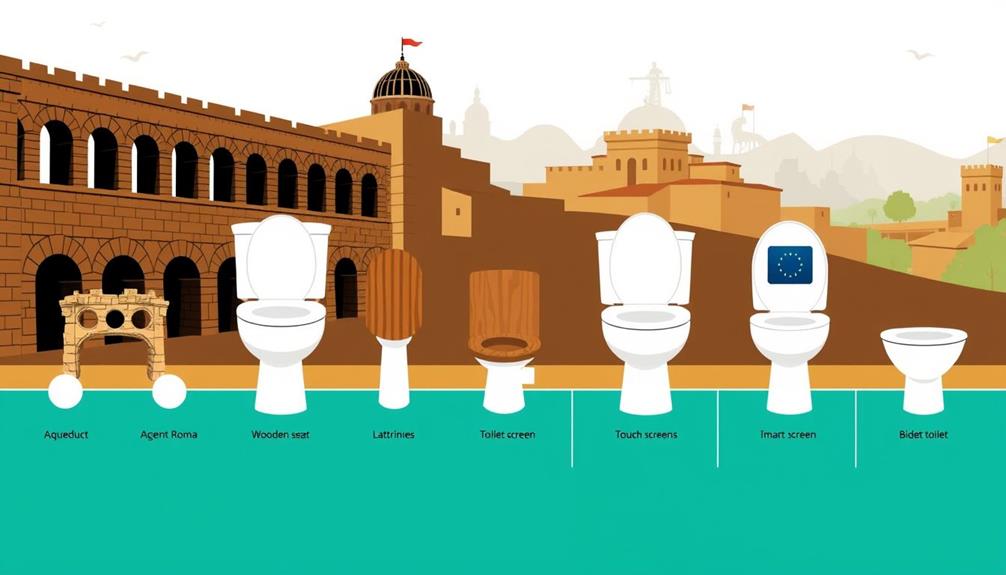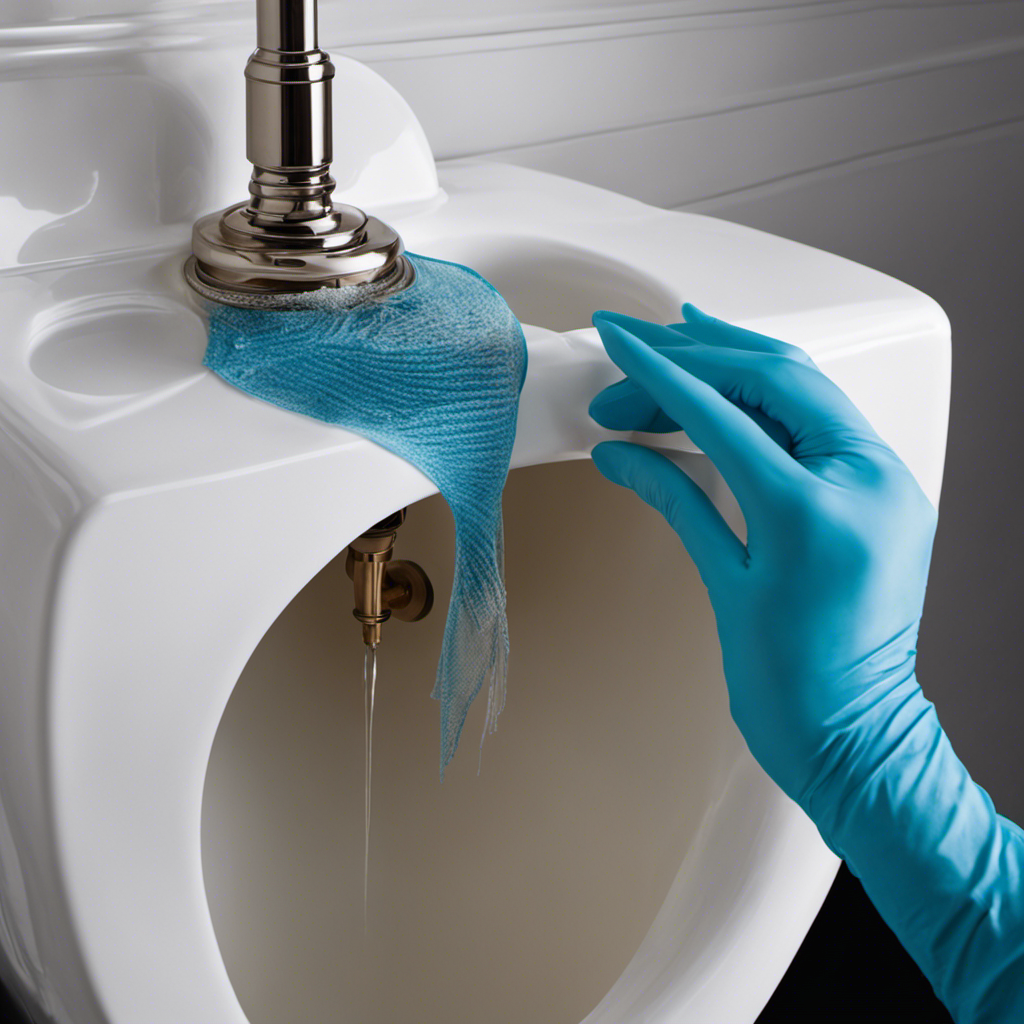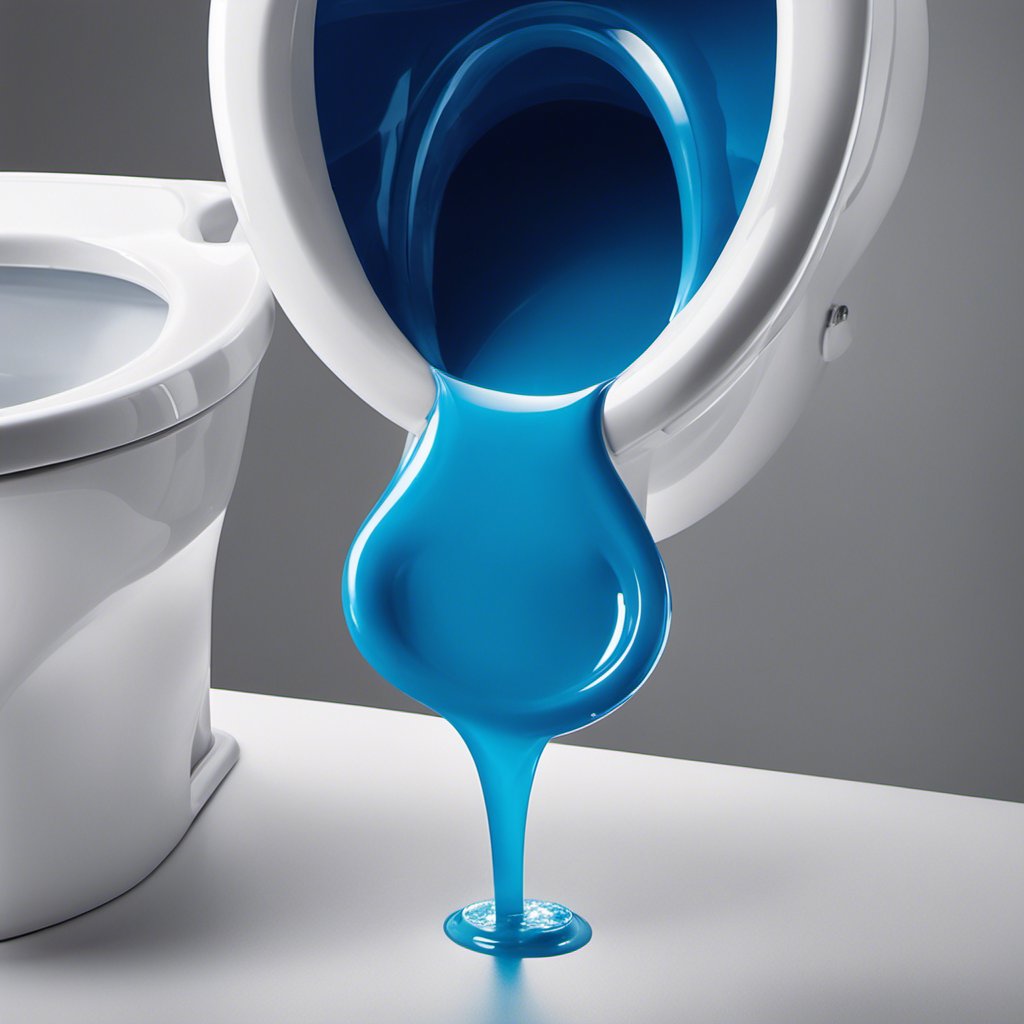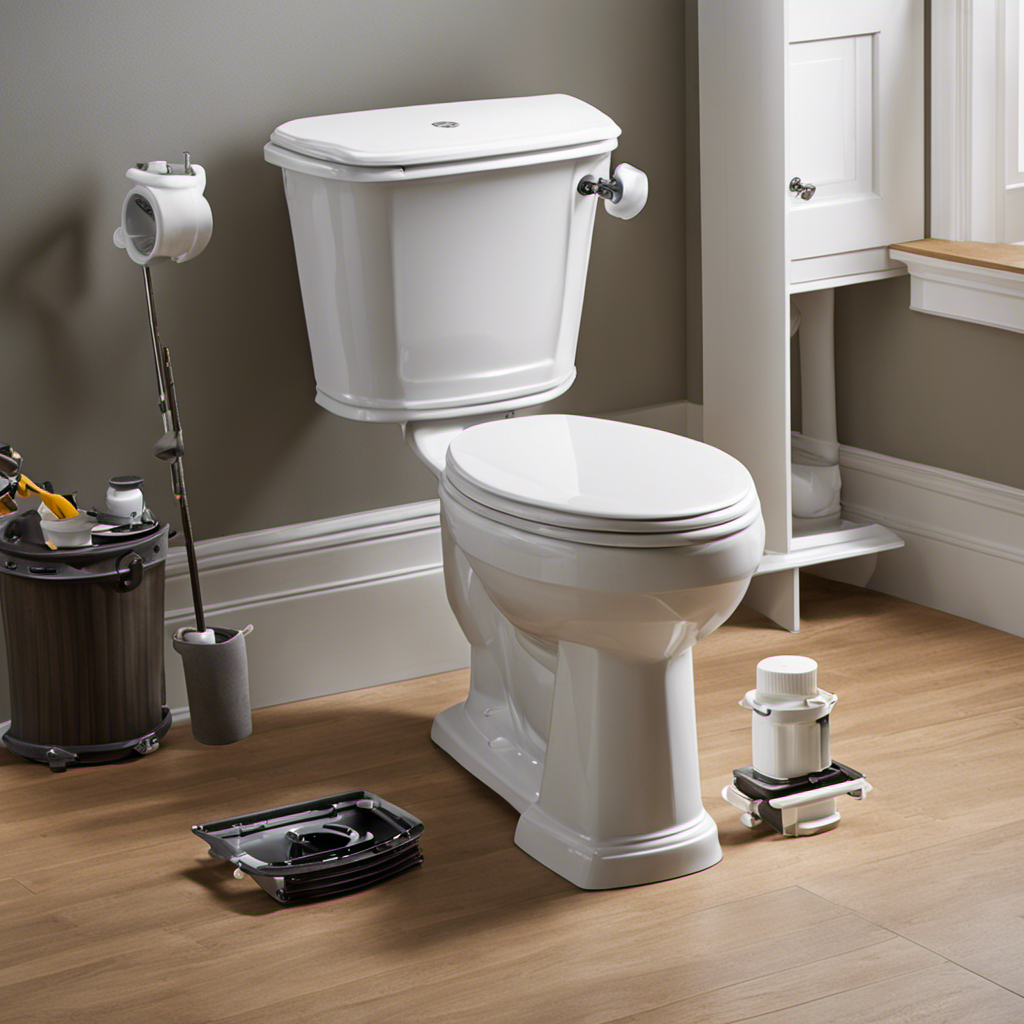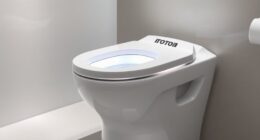Toilet technology has come a long way, shaping our hygiene practices over millennia. You can trace its roots back to the Indus Valley's advanced drainage systems and the Romans' communal toilets. Innovations surged with the flush toilet in the late 16th century, leading to widespread usage by the Victorian era. Fast forward to the 20th century, where automated toilets emerged, especially in Japan, boasting features like heated seats and self-cleaning functions. Today, smart toilets offer even more, including health monitoring and eco-friendly designs. Stick around to uncover how these advancements continue to redefine sanitation and wellness.
Key Takeaways
- Ancient civilizations, like the Indus Valley and Romans, pioneered early sanitation systems that laid the groundwork for modern plumbing.
- The invention of the flush toilet by Sir John Harington in 1596 marked a significant advancement in waste management technologies.
- The 19th century saw the widespread adoption of flush toilets, driven by urbanization and regulations aimed at improving public health.
- The rise of public toilets during the Industrial Revolution addressed sanitation needs in overcrowded urban areas and promoted hygiene awareness.
- Today's smart toilets feature innovations like heated seats, touchless flushing, and health monitoring, reflecting advancements in technology and sustainability.
Ancient Innovations in Sanitation
Throughout history, ancient innovations in sanitation have shaped the way we approach waste management today. The earliest known toilets, discovered in the Indus Valley Civilization around 2600 BC, featured advanced drainage systems that exemplified effective waste disposal methods. These toilets laid the foundation for improved sanitation systems that would evolve over time.
Understanding the importance of proper disposal has been a vital aspect of maintaining hygiene throughout history.
Ancient civilizations like the Romans took sanitation to another level, utilizing sophisticated plumbing technology with running water in communal toilets. This not only highlighted the importance of hygiene but also emphasized social interaction, as people gathered in these spaces.
The Minoans, around 1700 BC, introduced early flushing toilets that showcased advanced plumbing concepts with levers and water tanks, further revolutionizing waste management.
In Ancient Egypt, elevated toilet designs made from limestone slabs often included sand-filled pits for waste disposal, illustrating an understanding of sanitation needs.
These innovations reflect a commitment to enhancing public health and hygiene. The advancements in toilet technology during these early periods laid the groundwork for modern plumbing systems, demonstrating how essential ancient innovations in sanitation were to the development of waste management practices we rely on today.
The Flush Toilet Breakthrough

The flush toilet's invention marked a pivotal moment in sanitation history, transforming how people manage waste. You can appreciate how this breakthrough has shaped hygiene and comfort in everyday life, similar to how dog health and care has evolved to guarantee the well-being of our furry friends.
- Sir John Harington created the first flush toilet, the Ajax, in 1596.
- Alexander Cummings patented the S-trap in 1775, blocking sewer gases and improving indoor air quality.
- Thomas Crapper's enhancements in the 1880s revolutionized toilet design, making flush systems more reliable.
- Modern toilets have evolved to prioritize sanitation and user experience.
Despite Harington's innovative design, flush toilets struggled to gain traction due to inadequate plumbing infrastructure.
However, Cummings' S-trap was a game-changer, effectively addressing the issue of unpleasant odors.
Thanks to Crapper's improvements, public perception shifted, and the flush toilet gained popularity.
These early advancements laid the groundwork for the modern toilet systems you now rely on, highlighting the importance of efficient waste management in promoting hygiene.
Today's toilets reflect centuries of evolution, blending functionality with comfort to enhance your daily life.
Embracing this history helps you understand the significance of the flush toilet in our modern world.
Plumbing Advances in the 19th Century
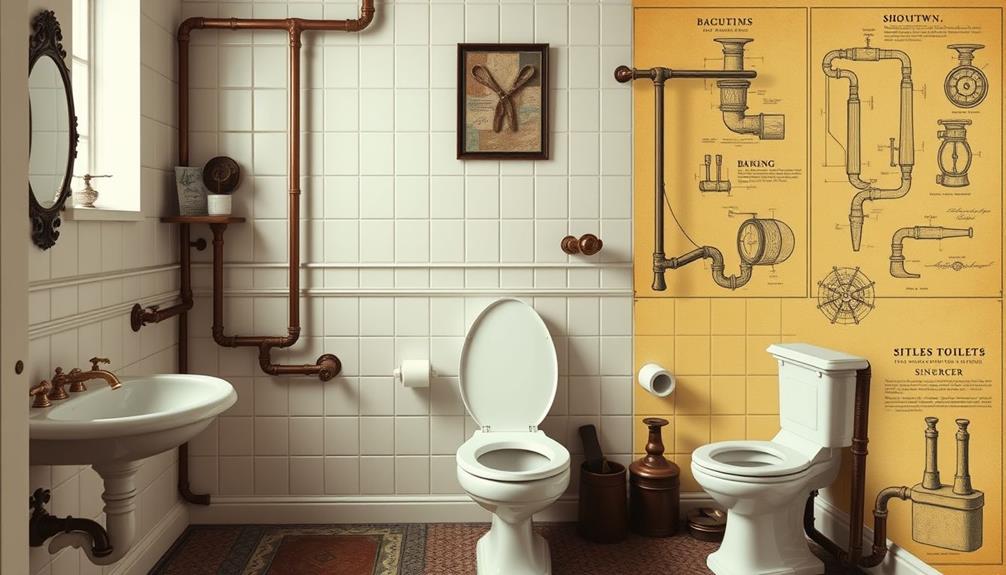
How did plumbing advancements during the 19th century transform the way you experience sanitation in your home? The Victorian era marked a turning point in plumbing technology, making flush toilets a common fixture in urban households.
With Alexander Cummings' patent of the first flush toilet featuring a water-seal trap in 1852, you benefited from improved indoor air quality, as this innovation effectively kept sewer gases at bay. Similar to how heat pump innovations have changed modern heating solutions, these plumbing advancements revolutionized sanitation in your daily life.
As urbanization surged, cities faced pressing sanitation issues, prompting increased awareness and the need for better waste management solutions. Municipal regulations emerged, pushing for upgraded toilet facilities and plumbing systems that catered to a growing population.
These advancements not only enhanced the functionality of toilets but also made them more accessible in your everyday life. The introduction of the S-trap in the early 1800s further solidified these improvements, ensuring that your home remained a cleaner and healthier environment.
Thanks to these plumbing advances, the way you handle waste and maintain sanitation today is fundamentally different, reflecting a significant evolution in public health and hygiene standards.
The Rise of Public Toilets
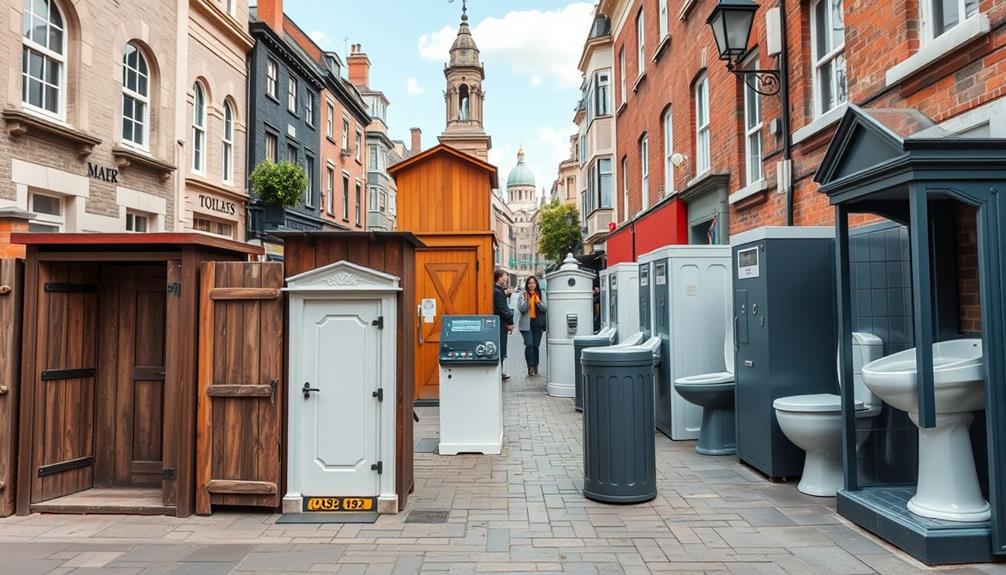
Public toilets emerged as essential facilities during the Industrial Revolution, addressing the urgent sanitation needs of rapidly growing urban populations. As cities expanded, the demand for proper hygiene and waste processing became critical, prompting the construction of notable facilities like Retiring Rooms to improve sanitation access.
The evolution of public amenities showcases how societies adapt to the challenges of urbanization, much like the need for diversification of retirement portfolios in finance.
- Increased health risks due to overcrowding
- Introduction of plumbing systems for better waste management
- Municipal regulations mandating public toilet maintenance
- Changing societal attitudes toward hygiene
The introduction of advanced plumbing systems considerably enhanced waste processing in public toilets, reducing health risks associated with inadequate sanitation. Public health campaigns in the 19th century underscored the connection between sanitation and health and hygiene, encouraging local governments to take action.
These campaigns led to the establishment of municipal regulations that required the construction and upkeep of public toilet facilities.
The rise of public toilets not only improved urban sanitation but also reflected a broader recognition of hygiene's role in public health and well-being. As society began to prioritize sanitation, public toilets became indispensable, showcasing the evolution of toilet technology in response to urban population growth during this transformative period.
The Age of Hygiene
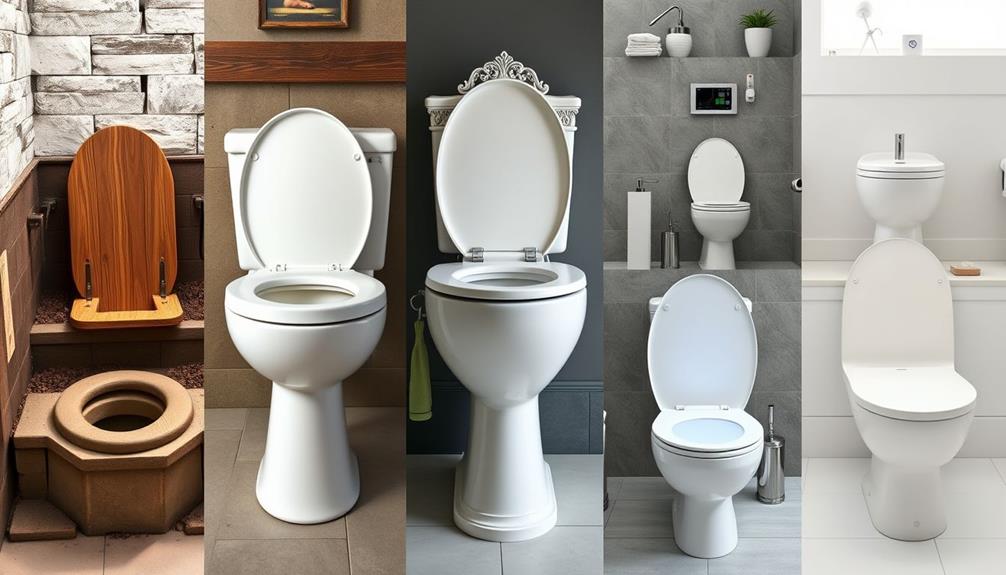
During the 20th century, hygiene standards transformed dramatically, revolutionizing how people interact with toilets. You likely noticed the shift toward more standardized toilet designs in households and public facilities. The introduction of flushable toilet paper rolls in 1906 greatly enhanced personal hygiene, changing bathroom habits for the better.
As societies began to recognize the importance of mental health and its connection to overall well-being, the role of hygiene practices, including those related to toilet use, became increasingly crucial in maintaining both physical and emotional health. This emphasis on hygiene aligns with the need for supportive resources and education in personal care, as highlighted by the Community and Support Resources.
As awareness of public health grew, so did the demand for comfort and convenience in toilet technology. The 1980s brought the innovative dual-flush system, created by Bruce Thompson, allowing you to choose between two flushing options for better water conservation. This not only saves water but also reflects a deeper understanding of the environmental impact of our choices.
In modern times, the availability of bidets has surged, further enhancing hygiene and becoming a standard feature in many bathrooms. These advancements denote a collective commitment to improving sanitation practices.
With the rise of smart toilets on the horizon, you can expect even more innovations that prioritize personal hygiene and public health. Today's toilets aren't just functional; they represent a blend of comfort, convenience, and eco-friendliness that continues to evolve.
Post-War Automated Toilets

In the years following World War II, Japan saw an explosion of innovation in automated toilet technology, spurred by both an economic boom and a cultural commitment to cleanliness. These post-war advancements transformed the way people interacted with toilets, minimizing human contact through cutting-edge designs.
This period also witnessed the introduction of features that echoed the principles of candle safety precautions, such as self-cleaning functions that enhanced hygiene and convenience.
- Advanced flushing mechanisms
- Self-cleaning functions
- Heated seats and bidet features
- Noise masking technology
Manufacturers like Toto led the charge, introducing automated toilets that prioritized hygiene and comfort. With features that catered to modern needs, these toilets became essential conveniences in Japanese households, boasting a remarkable adoption rate of over 75% by 2022.
This emphasis on cleanliness and innovation established a foundation for what we now consider standard in automated toilets. As Japan pushed the boundaries of toilet technology, it set a benchmark that would eventually influence global markets, including the U.S., which began to embrace these advanced features around 2014.
The post-war era marked a significant shift in how toilets are perceived and utilized, showcasing Japan's commitment to both functionality and cleanliness in everyday life.
The Japanese High-Tech Revolution

Building on the innovations of the post-war era, the Japanese high-tech revolution has further transformed toilet technology into a marvel of modern convenience and hygiene. As of 2022, over 75% of households in Japan embraced smart toilets, showcasing the nation's commitment to cleanliness and innovation.
Here's a glimpse of some remarkable features found in these advanced toilets:
| Feature | Description |
|---|---|
| Heated Seats | Provides warmth for a comfortable experience. |
| Bidet Functions | Offers personalized washing options for hygiene. |
| Self-Cleaning | guarantees the toilet stays clean with minimal effort. |
Japanese brands like Toto and Panasonic have pioneered these advancements, introducing not just standard functions but also music speakers and air deodorizers to enhance your experience. The evolution began in the 1980s, and today, smart toilets continue to push the boundaries of technology with Bluetooth connectivity and potential health monitoring features. This relentless drive for innovation keeps Japan at the forefront of toilet technology, setting a global standard for modern sanitation solutions.
Smart Toilet Features
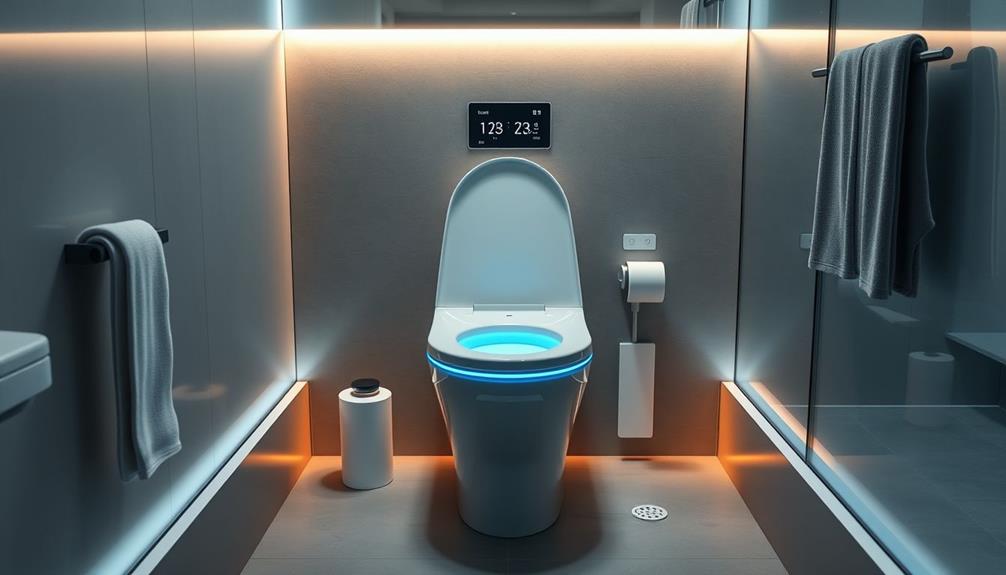
Smart toilets represent a significant leap in bathroom technology, offering a blend of comfort, hygiene, and convenience that traditional toilets simply can't match.
These innovative fixtures not only enhance your daily routine but also contribute to a smarter home environment. In fact, the importance of maintaining a clean indoor environment is echoed in the benefits of using advanced technology like air purifiers in your home.
Here are some standout features you can expect:
- Heated seats for ultimate comfort in cooler climates
- Touchless flushing that reduces germ spread
- Self-cleaning mechanisms utilizing UV light to maintain hygiene
- Health monitoring features that analyze urine and stool
With heated seats, you can say goodbye to chilly mornings.
The integrated bidet functions promote hygiene by reducing the need for toilet paper, making this an eco-friendly alternative.
Self-cleaning mechanisms minimize bacteria buildup, ensuring a cleaner environment, while touchless flushing helps maintain health and cleanliness.
Additionally, health monitoring features can provide you with valuable insights into your wellness, making these toilets not just a luxury but a potential health tool.
Smart toilets also focus on water efficiency, helping you save on utilities while enjoying the benefits of advanced technology.
Embracing a smart toilet means embracing comfort, hygiene, and sustainability all at once.
Future of Toilet Technology
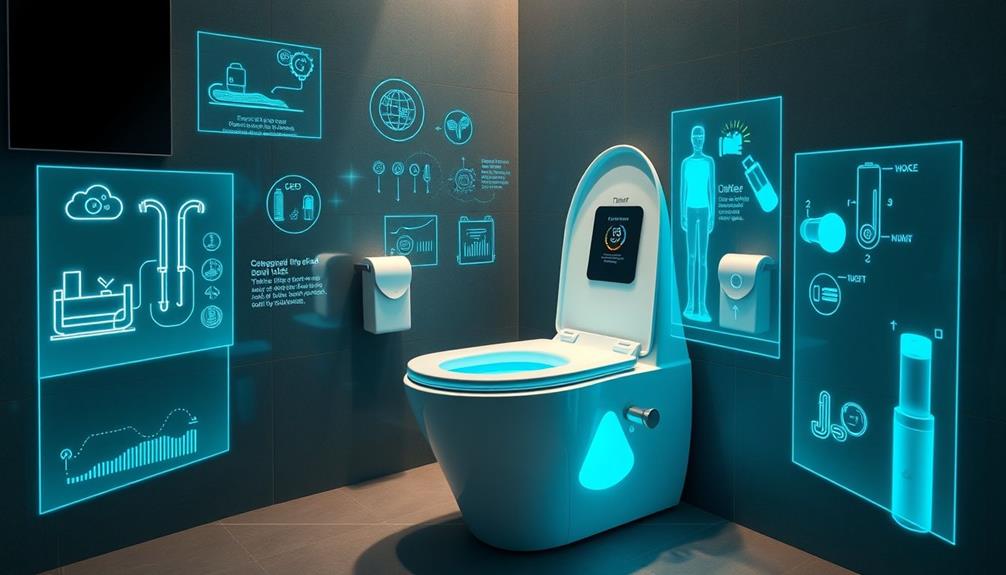
As toilet technology advances, you'll see a shift towards integrating health monitoring features that analyze your waste for potential health issues.
This innovation not only enhances personal hygiene but also aligns with sustainable practices in design, ensuring eco-friendly materials and manufacturing practices.
Health Monitoring Integration
Integrating health monitoring into toilet technology promises to revolutionize how we manage our well-being. Imagine a world where your toilet not only serves its primary function but also acts as a crucial health assistant. Smart toilets equipped with advanced sensors can track important health metrics, providing real-time feedback that empowers you to take charge of your health.
This approach aligns with a thorough lifestyle that supports not only physical health but also stress management techniques for overall well-being.
- Early detection of health conditions through urine and stool analysis
- Monitoring of hydration levels to optimize wellness
- Personalized health assessments using AI technology
- Seamless sharing of health data with healthcare providers
With the rise of smart toilets, users can benefit from sophisticated health monitoring capabilities that support preventive healthcare. This technology allows for the analysis of bodily waste, leading to insights about potential infections or other health issues.
As smart toilets continue to evolve, you can expect personalized wellness recommendations tailored just for you. The integration of these features not only enhances your daily routine but also contributes to more effective disease management and an overall healthier lifestyle.
Embracing this innovative technology could greatly change how you prioritize your health and wellness.
Sustainable Design Innovations
With health monitoring technology paving the way for smarter bathroom experiences, the focus is now shifting toward sustainability in toilet design. Sustainable design innovations are revolutionizing the way we think about toilets, making them more eco-friendly and efficient.
You'll find water-efficient toilets that use as little as 1.28 gallons per flush, a significant reduction compared to older models. Composting toilets are also gaining popularity, transforming waste into usable compost and reducing landfill contributions. Smart toilets now often feature dual-flush systems, giving you the option of a full or half flush to further promote water conservation.
Here's a quick overview of these innovations:
| Innovation | Description | Benefits |
|---|---|---|
| Water-Efficient Toilets | Use as little as 1.28 gallons per flush | Significant water savings |
| Composting Toilets | Converts waste into compost | Reduces landfill waste |
| Smart Toilets | Incorporate advanced technology for monitoring usage | Encourages sustainable habits |
Frequently Asked Questions
How Has the Toilet Changed Over Time?
Toilets have transformed considerably, from basic pit latrines to sophisticated flush systems. You've experienced advancements like water efficiency, touchless features, and enhanced hygiene, all designed to improve your comfort and promote better sanitation practices.
When Was the Smart Toilet Invented?
The smart toilet started gaining traction in the 1980s with Japan's Toto introducing the Washlet. By 2014, modern features like heated seats and touchless operation became popular in the U.S., changing how you think about toilets.
What Is the History of the Invention of the Toilet?
Toilets are the unsung heroes of hygiene. You'll find their origins in ancient civilizations, evolving through time with innovations like the flush system and S-trap, leading to today's smart toilets that redefine comfort and cleanliness.
How Did Ancient Toilets Work?
Ancient toilets worked by utilizing gravity and water systems to manage waste. You'd sit over a hole or bench, while water flowed through channels, carrying waste away, maintaining cleanliness and hygiene in communal settings.
Conclusion
Toilet technology has come a long way, evolving from ancient sanitation methods to today's smart toilets. Did you know that nearly 60% of the world's population still lacks access to improved sanitation facilities? As we look ahead, the integration of technology in bathrooms promises not just convenience but also enhanced hygiene and sustainability. Embracing these advancements can lead to a cleaner, healthier future for everyone. So, next time you sit down, think about the journey that brought us here!
